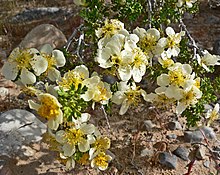Purshia
| Purshia | |
|---|---|

| |
| Purshia stansburyana | |
| Scientific classification | |
| Kingdom: | Plantae |
| Clade: | Tracheophytes |
| Clade: | Angiosperms |
| Clade: | Eudicots |
| Clade: | Rosids |
| Order: | Rosales |
| Family: | Rosaceae |
| Subfamily: | Dryadoideae |
| Genus: | Purshia DC.exPoir. |
| Type species | |
| Purshia tridentata | |

| |
| Range | |
| Synonyms | |
| |
Purshia(bitterbrushorcliff-rose) is a smallgenusof 5–8 species offlowering plantsin the familyRosaceaewhich are native to westernNorth America.
Description
[edit]Purshiaspecies formdeciduousorevergreenshrubs,typically reaching0.3–5 metres (1–16+1⁄2feet) tall. Theleavesare1–3 centimetres (1⁄2–1+1⁄4inches) long, deeply three- to five-lobed, with revolute margins. Theflowersare 1–2 cm in diameter, with five white to pale yellow or pink petals and yellow stamens. Thefruitis a cluster of dry, slender, leatheryacheneswhich are 2–6 cm long. The roots havenodulesthat hostnitrogen-fi xingFrankiabacterium.[1]
Taxonomy
[edit]Taxonomic history
[edit]The genus was originally placed in the subfamilyRosoideae.[2]In the past, theevergreenspecies were treated separately in the genusCowania;this genus is still accepted by some botanists.
Modern classification
[edit]The classification ofPurshiawithin the familyRosaceaehas been unclear.[3][4]It is now placed in the subfamilyDryadoideae.[2]
Species
[edit]Purshiacomprises the following species:[5][6]
- Purshia ericifolia(Torr. ex A.Gray) Henr.– Heath cliffrose (Texas)
- Purshia glandulosaCurran– Desert bitterbrush (Nevada, Utah, Arizona)
- Purshia mexicana(D.Don) Henr.– Mexican cliffrose (Mexico, Arizona)
- Purshia pinkavaeSchaack–Pinkava'scliffrose (Arizona)
- Purshia plicata(D.Don) Henrard(syn.Cowania plicata) – Antelope bush (Nuevo León, Mexico).
- Purshia stansburyana(Torr.) Henr.– Stansbury cliffrose (Idaho south to California, Arizona and New Mexico)
- Purshia tridentata(Pursh) DC.– Antelope bitterbrush (British Columbia south to California and New Mexico)
Hybrids
[edit]The followinghybridhas been described:[5]
- Purshia×subintegra(Kearney) Henr.(P. pinkavae×P. stansburyana) – (Arizona)
Species names with uncertain taxonomic status
[edit]The status of the following species and hybrids is unresolved:[5]
- Purshia ciliataDennst.
- Purshia mollisLehm.
- Purshia plicata(D.Don) Henr.
- Purshia subintegra(Kearney) Henrickson
Distribution and habitat
[edit]The genus is native to westernNorth America,where the species grow in dry climates from southeastBritish Columbia,Canada,south throughout thewestern United Statestonorthern Mexico.
Gallery
[edit]-
P. tridentata,Lava Beds National Monument
-
P. stansburiana,Red Rock Canyon,Nevada
-
P. stansburiana,Red Rock Canyon, Nevada
References
[edit]- ^Swensen, S.M.; Mullin, B.C. (1997). "The impact of molecular systematics on hypotheses for the evolution of root nodule symbioses and implications for expanding symbioses to new host plant genera".Plant and Soil.194(1–2): 185–192.doi:10.1023/A:1004240004063.
- ^abPotter, D.; Eriksson, T.; Evans, R.C.; Oh, S.; Smedmark, J.E.E.; Morgan, D.R.; Kerr, M.; Robertson, K.R.; Arsenault, M.; Dickinson, T.A.; Campbell, C.S. (2007). "Phylogeny and classification of Rosaceae".Plant Systematics and Evolution.266(1–2): 5–43.doi:10.1007/s00606-007-0539-9.
- ^Morgan, D.R.; Soltis, D.E.; Robertson, K.R. (1994). "Systematic and evolutionary implications of rbcL sequence variation in Rosaceae".American Journal of Botany.81(7): 890–903.doi:10.1002/j.1537-2197.1994.tb15570.x.JSTOR2445770.
- ^Eriksson, T.; Hibbs, M.S.; Yoder, A.D.; Delwiche, C.F.; Donoghue, M.J. (2003). "The phylogeny of Rosoideae (Rosaceae) based on sequences of the internal transcribed spacers (ITS) of nuclear ribosomal DNA and the trnL/F region of chloroplast DNA".International Journal of Plant Sciences.164(2): 197–211.doi:10.1086/346163.
- ^abc"The Plant List entry forPurshia".The Plant List,v.1.1.Royal Botanic Gardens, Kewand theMissouri Botanical Garden.September 2013.Retrieved15 December2020.
- ^Govaerts R."PurshiaDC. ex Poir ".Plants of the World Online.Board of Trustees of the Royal Botanic Gardens, Kew.Retrieved15 December2020.
External links
[edit] Media related toPurshiaat Wikimedia Commons
Media related toPurshiaat Wikimedia Commons- Jepson Flora Project:Purshia—(click 'taxon' to see treatments of California native species)



